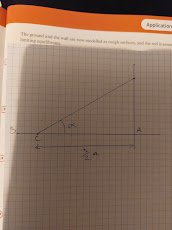James10492
Junior Member
- Joined
- May 17, 2020
- Messages
- 50
Hi again, you guessed it, more mechanics:

A uniform beam AB, of mass M and length 2a, rests with its end A against a rough vertical wall. The beam is held in a horizontal position by a rope. One end of the beam is attached to the rod at a point C that lies .5a from B, and the other end is attached to the wall at a point D that lies vertically above A. The coefficient of friction between the wall and the beam is .4, and the angle between the rope and the rod is alpha.
Now the first part of the problem asks you to show, given the above information, and given that the beam is held in equilibrium, that the magnitude of the tension in the rope is equal to
[math]\frac{2Mg}{3\sin\alpha}[/math]
Taking moments about A,
[math]Mg*a=\frac{3}{2}a*\sin\alpha*T \\ T = \frac{Mg*a}{\frac{3}{2}a*\sin\alpha} \\ T = \frac{2Mg}{3\sin\alpha}[/math]
as required.
Now the next part is to find the horizontal and vertical components of the force exerted on the beam by the wall. Resolving forces horizontally,
[math]H = T\cos\alpha \\ H = \cos\alpha(\frac{2Mg}{3\sin\alpha}) \\ H = \frac{2Mg}{3\tan\alpha}[/math]
Now here is where I have a problem. Resolving forces vertically,
[math]Mg = T\sin\alpha +.4H+V \\ V = Mg - \frac{2}{3}Mg-.4(\frac{2Mg}{3\tan\alpha})[/math]
But, apparently, the solution is that V = Mg/3, as though you don't need to take into account the frictional force of the wall. Is this because V and F work in the same plane? (This doesn't sense to me, I am sure I have come across problems before where this is the case).

A uniform beam AB, of mass M and length 2a, rests with its end A against a rough vertical wall. The beam is held in a horizontal position by a rope. One end of the beam is attached to the rod at a point C that lies .5a from B, and the other end is attached to the wall at a point D that lies vertically above A. The coefficient of friction between the wall and the beam is .4, and the angle between the rope and the rod is alpha.
Now the first part of the problem asks you to show, given the above information, and given that the beam is held in equilibrium, that the magnitude of the tension in the rope is equal to
[math]\frac{2Mg}{3\sin\alpha}[/math]
Taking moments about A,
[math]Mg*a=\frac{3}{2}a*\sin\alpha*T \\ T = \frac{Mg*a}{\frac{3}{2}a*\sin\alpha} \\ T = \frac{2Mg}{3\sin\alpha}[/math]
as required.
Now the next part is to find the horizontal and vertical components of the force exerted on the beam by the wall. Resolving forces horizontally,
[math]H = T\cos\alpha \\ H = \cos\alpha(\frac{2Mg}{3\sin\alpha}) \\ H = \frac{2Mg}{3\tan\alpha}[/math]
Now here is where I have a problem. Resolving forces vertically,
[math]Mg = T\sin\alpha +.4H+V \\ V = Mg - \frac{2}{3}Mg-.4(\frac{2Mg}{3\tan\alpha})[/math]
But, apparently, the solution is that V = Mg/3, as though you don't need to take into account the frictional force of the wall. Is this because V and F work in the same plane? (This doesn't sense to me, I am sure I have come across problems before where this is the case).

